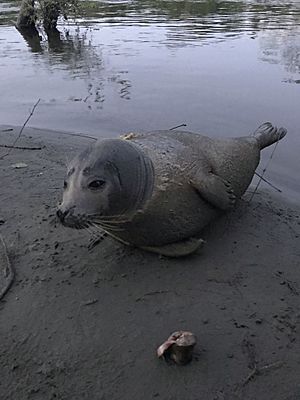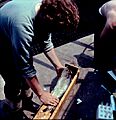American shad facts for kids
Quick facts for kids American shad |
|
|---|---|
 |
|
| Watercolor of an American shad by Sherman F. Denton, 1904: The swelling between the anal fin and ventral fin identifies this as a gravid female. | |
| Conservation status | |
| Scientific classification | |
| Kingdom: | |
| Phylum: | |
| Class: | |
| Order: | |
| Family: | |
| Subfamily: | |
| Genus: |
Alosa
|
| Subgenus: |
A. (Alosa)
|
| Species: |
A. (A.) sapidissima
|
| Binomial name | |
| Alosa (Alosa) sapidissima (A. Wilson, 1811)
|
|
| Synonyms | |
|
Clupea sapidissima |
|
The American shad (Alosa sapidissima) is a type of fish that lives in both fresh and salt water. It is known as an anadromous fish, meaning it lives in the Atlantic Ocean but swims up freshwater rivers to lay its eggs. You can find American shad along the North American coast, from Newfoundland in Canada all the way down to Florida. It was also introduced to the Pacific Ocean coast.
This fish has been called "the fish that fed the (American) nation's founders" because it was an important food source long ago. Adult shad usually weigh between 3 and 8 pounds (1.4 to 3.6 kg). They have a light, delicate flavor and are often eaten boiled, fried, or baked. Many people enjoy them without adding many sauces or spices. In the Eastern United States, female shad with eggs (called roe) are especially popular.
The word "shad" comes from an old English word, sceadd, which means "herring". This shows that shad are related to herring.
Contents
Life of the American Shad
American shad spend most of their lives in the Atlantic Ocean. But when it's time to lay eggs, they swim up rivers. Some shad, especially those in northern areas, can survive after laying eggs and return to the ocean. They might come back to rivers to lay eggs several more times. However, shad in southern areas usually lay eggs once and then die, much like salmon.
Where Do Shad Live in the Ocean?
In the ocean, shad swim together in large groups called schools. You can often see thousands of them near the surface in spring, summer, and autumn. During winter, they tend to swim deeper, sometimes as deep as 65 fathoms (119 meters). They prefer water temperatures between 13 and 18 degrees Celsius (55 to 64 degrees Fahrenheit) before they go to lay eggs.
What Do American Shad Eat?
Like other herring, American shad mainly eat tiny ocean creatures called plankton. They also eat small shrimp and fish eggs. Sometimes, they might eat very small fish, but this is not a big part of their diet.
When Do Shad Lay Eggs?
Sexually mature American shad enter rivers in spring or early summer. This usually happens when the river water warms up to about 10 to 13 degrees Celsius (50 to 55 degrees Fahrenheit). If the water is too cold, they might delay their journey. This means the shad run (when they swim upriver) happens later in the year as you go from south to north along the coast. For example, it starts in Georgia in January, but in Delaware and Canada, it's in May and June.
In big rivers like the Connecticut River, American shad can swim very far upstream. The longest known journey is in the St. Johns River in Florida, where shad have been found 375 miles (604 km) upriver!
How Do Shad Lay Eggs?
When it's time to lay eggs, the fish choose shallow areas with sand or pebbles. They usually lay their eggs between sunset and midnight. A female shad can release about 30,000 eggs at a time. Very large females can lay as many as 156,000 eggs in one go. Over a year, a female can produce between 200,000 and 600,000 eggs. After laying eggs, most shad in northern rivers return to the sea. However, in southern rivers, most shad die after laying their eggs.
The eggs are clear and can be pale pink or amber. They are not sticky and roll around on the river bottom with the current. The eggs hatch in 12 to 15 days if the water is around 11 degrees Celsius (52 degrees Fahrenheit). If the water is warmer, around 17 degrees Celsius (63 degrees Fahrenheit), they hatch in six to eight days.
When the baby fish, called fry, hatch, they are about 9 to 10 millimeters long. Young shad stay in the rivers until fall. Then, they swim down to the ocean. By this time, they are about 1.5 to 4.5 inches (3.8 to 11.4 cm) long and look like smaller versions of their parents.
Shad and Their Environment
As adult shad swim in the ocean and travel back to rivers to lay eggs, they are hunted by other animals. Predators like striped bass and harbor seals often chase them. Shad might not actively eat much during their journey to lay eggs.
Nutritional Benefits of American Shad
Like most herring, American shad are very rich in omega 3 fatty acids. These are healthy fats that are good for your body. Shad actually have almost twice as much omega 3 per serving as wild salmon. They are also very low in harmful substances like PCBs, dioxins, and mercury, according to environmental estimates. This makes American shad a valuable and healthy food fish.
American Shad Populations
People noticed that the number of shad along the Atlantic coast started to drop as early as the 1900s. In the past, shad were caught in nets placed in rivers. Many rivers where shad used to be common now have pollution. However, shad don't spend much time in fresh water, which might help them avoid too much contamination. For example, scientists found that shad in the Hudson River don't stay long enough to be affected by certain pollutants. Still, fishing for American shad in the Hudson River is now not allowed.
Many rivers that shad use are now blocked by dams. These dams prevent shad from reaching their traditional places to lay eggs. For instance, the number of shad caught in the Merrimack River dropped from almost 900,000 in 1789 to zero in 1888 because of many dams being built. Today, people are working to help fish get past dams, for example, through the Chesapeake Bay program.
While fishing for fun (recreational angling) doesn't hurt shad numbers much, catching too many for sale (commercial overfishing) can be a problem. Because shad travel long distances and are important for both fun and business, they are managed by several groups. These include the U.S. Fish and Wildlife Service, the National Marine Fisheries Service, and state fishing agencies. The Atlantic States Marine Fish Commission helps coordinate these efforts to protect American shad.
Shad Introduced to the North Pacific
American shad were brought to the San Francisco Bay and Sacramento River system in California in the 1800s. From there, they have spread to many other rivers on the West Coast of North America. A large group of shad now lives in the Columbia River. In recent years, millions of shad have been counted at dams like Bonneville and The Dalles Dam. Unlike some introduced species, American shad don't seem to cause serious harm to the environment or other native fish in the Columbia River.
Sometimes, American shad are also found far away in Kamchatka, Russia, on the Northwest Pacific coast.
Fishing for Shad

Shad are also popular for sport fishing. They have interesting feeding behaviors when they are swimming upriver to lay eggs, which scientists are still trying to understand. Unlike salmon, shad can still digest food while they are migrating upriver. Their urge to feed can be triggered by things like how clear the water is or its temperature.
Shad in Culture and History
Shad play important symbolic roles in certain regions and their traditions. For example, in Wakefield, Virginia, there's an event called Shad Planking held every four years during the governor's election. Future politicians, lobbyists, and reporters gather there.
In Connecticut, the towns of Essex and Windsor have yearly shad festivals. Also, every spring, the town of Lambertville, New Jersey, which is across the Delaware River from New Hope, Pennsylvania, hosts an annual Shad Festival. A big Shad Festival called ShadFest is also held in Wilmington, Delaware, along the Brandywine River, attracting many people.
There is even a museum dedicated to shad on the Connecticut River in Haddam, Connecticut.
Long ago, in the 1680s, William Penn made an agreement with the Lenape people for the shad fishing grounds on the Schuylkill River. He said that shad were "excellent Pickled or Smoked."
Images for kids
-
An American shad is measured during a survey at the Holyoke Dam fish ladder, circa 1970
See also
 In Spanish: Alosa sapidissima para niños
In Spanish: Alosa sapidissima para niños




